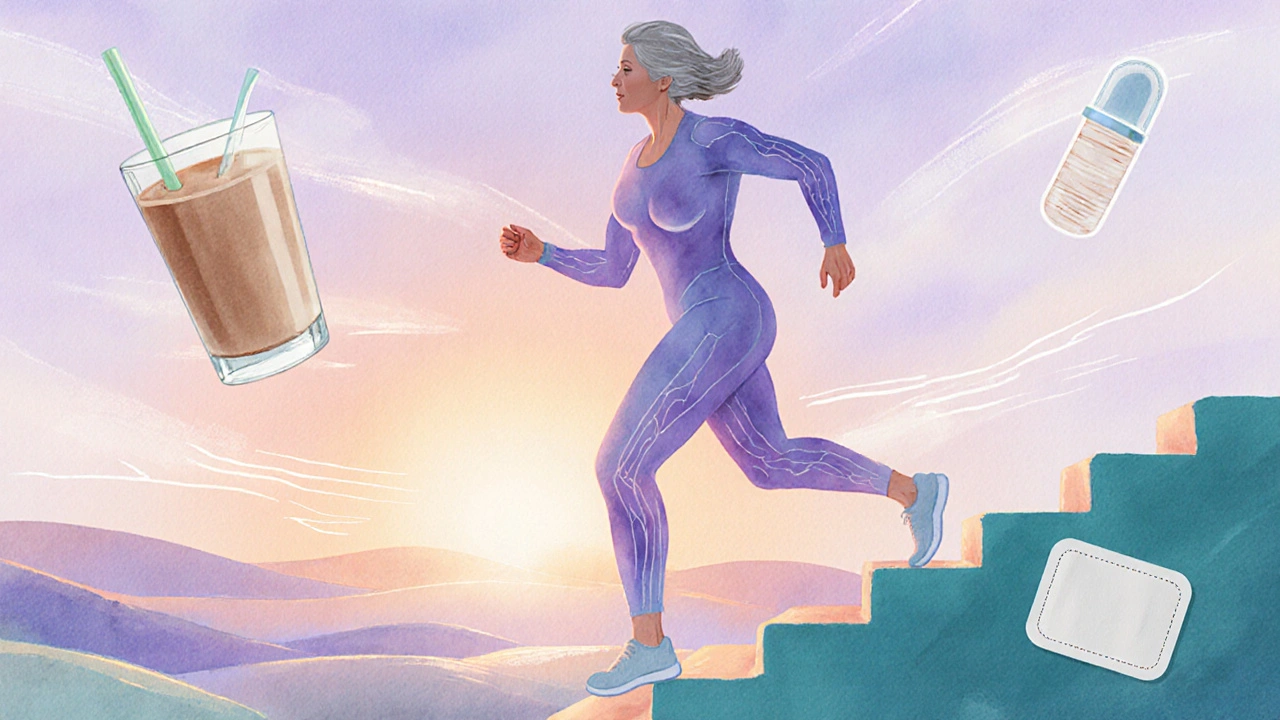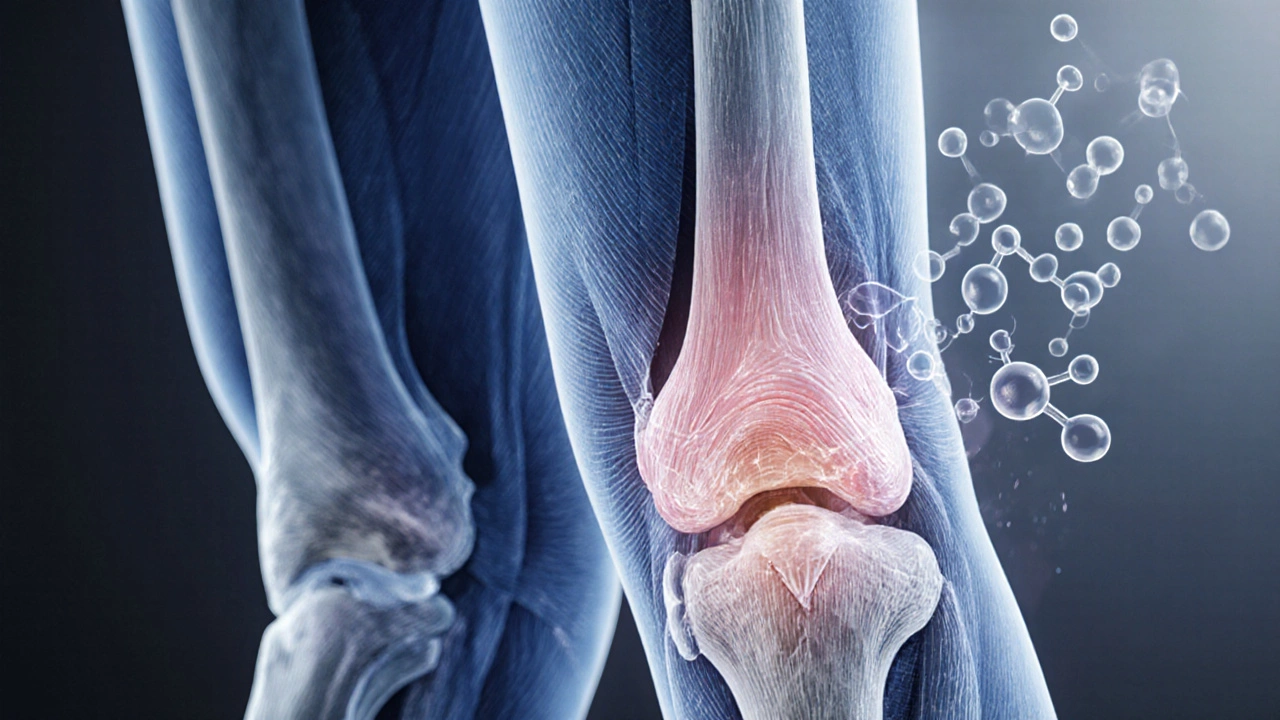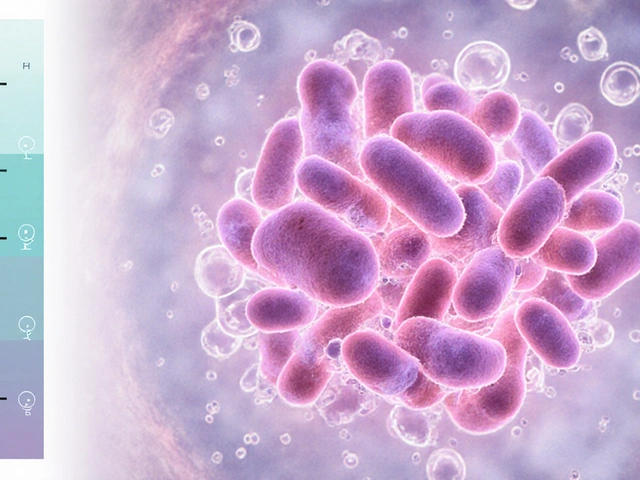Menopause Muscle Strength Calculator
Calculate your daily protein needs, estimate potential muscle loss during menopause, and see which strategies can help maintain your strength and tendon health.
Protein Needs
Based on your inputs, you should consume 0g of protein daily to support muscle health.
Recommended range: 1.2-1.5g per kg of body weight
When the hot flashes start and periods disappear, most women focus on mood swings or weight changes. But there’s another hidden shift happening under the skin-your muscles and tendons are quietly reacting to the hormonal roller‑coaster of menopause. Understanding how this transition affects your connective tissue can mean the difference between staying active and dealing with frequent aches, weakness, or injuries.
Key Takeaways
- Estrogen drops trigger muscle‑protein breakdown and reduce tendon elasticity.
- Strength loss (sarcopenia) can begin within a year of menopause.
- Targeted resistance training, adequate protein, and vitamin D can offset most changes.
- Hormone replacement therapy (HRT) helps some women, but risks must be weighed.
- Watch for persistent joint pain, sudden weakness, or reduced flexibility-these may need professional evaluation.
Below, we break down the science, share practical steps, and compare the most common ways to protect your musculoskeletal health during this life stage.
What Happens to Hormones During Menopause?
Menopause is a natural, permanent cessation of ovulation that typically occurs between ages 45 and 55. During this phase, ovarian production of estrogen and progesterone drops dramatically, affecting nearly every organ system. One of the lesser‑talked‑about consequences is the impact on muscle fibers and tendon collagen, which rely on estrogen for repair and maintenance.
How Low Estrogen Affects Your Muscles
Estrogen plays a key role in muscle‑protein synthesis. With its decline, the body shifts toward a catabolic state, meaning muscle tissue breaks down faster than it builds up. This accelerates Sarcopenia, the age‑related loss of muscle mass and strength, often by 1‑2% per year after the menopausal transition.
Research from the Women’s Health Initiative showed that women in early post‑menopause lost an average of 0.5kg of lean mass per year, compared to 0.1kg during the pre‑menopausal years. The loss is most noticeable in the lower body-quadriceps, hamstrings, and glutes-making activities like climbing stairs feel harder.

What Changes Occur in Tendons?
Tendons are bundles of collagen that attach muscle to bone. Estrogen helps keep collagen fibers flexible and well‑organized. When estrogen falls, tendons become stiffer and less able to absorb shock, raising the risk of tendinopathy and micro‑tears.
Studies measuring Achilles tendon stiffness in post‑menopausal women found a 15‑20% increase compared to pre‑menopausal controls. This added rigidity can turn ordinary activities-like a brisk walk-into a source of joint pain.
Ways to Protect Muscles and Tendons
Luckily, the body isn’t powerless. A combination of movement, nutrition, and-if appropriate-medical interventions can blunt these changes.
Resistance Training
Strength training is the single most effective tool to combat menopause muscle loss. Lifting weights or using resistance bands stimulates muscle‑protein synthesis, even in low‑estrogen environments. Aim for at least two sessions per week, focusing on major muscle groups:
- Squats or sit‑to‑stands (3×10‑12 reps)
- Dead‑lifts or hip hinges (3×8‑10 reps)
- Push‑ups or chest presses (3×8‑12 reps)
- Rows or lat pulls (3×10‑12 reps)
- Calf raises (3×12‑15 reps)
Progressively increase weight or resistance every 2‑3 weeks to keep muscles adapting.
Nutrition for Muscle & Tendon Health
Protein is the building block of both muscle fibers and tendon collagen. Aim for 1.2-1.5g of protein per kilogram of body weight daily. Good sources include lean poultry, fish, eggs, Greek yogurt, and plant‑based options like lentils and tofu.
Vitamin D supports calcium absorption and muscle function. Post‑menopausal women often have serum 25‑OH‑D levels below 30ng/mL; a daily supplement of 1,000-2,000IU can bring levels into the optimal range.
Collagen peptides (10g per day) have shown modest improvements in tendon elasticity when combined with vitamin C, which aids collagen synthesis.
Hormone Replacement Therapy (HRT)
For women with severe symptoms or rapid musculoskeletal decline, HRT can restore estrogen levels and improve muscle strength and tendon pliability. Typical regimens include:
- Oral estradiol 0.5-1mg daily
- Transdermal patches delivering 0.025-0.05mg/day
- Combined estrogen‑progestin pills for women with an intact uterus
Clinical trials report a 5‑10% increase in lean body mass after six months of HRT, but the therapy carries risks such as blood clots and breast cancer. Discuss personal risk factors with a healthcare provider before starting.
Lifestyle Tweaks
Sleep quality, stress management, and adequate hydration all influence muscle recovery. Aim for 7-9hours of sleep, practice mindfulness or yoga to lower cortisol (which can degrade muscle), and drink at least 2L of water daily.
Comparison of Intervention Strategies
| Strategy | Effectiveness for Muscle/Tendon | Ease of Adoption | Typical Cost (US$ per year) | Key Risks/Contraindications |
|---|---|---|---|---|
| Resistance Training | High - 20‑30% strength gain in 12 weeks | Moderate - gym access or home equipment needed | 0‑300 (gym membership or dumbbells) | Injury if form is poor |
| Protein‑Rich Nutrition | Medium - supports 5‑8% lean mass increase | Easy - dietary adjustments | 50‑200 (food/supplements) | Kidney issues at very high intakes |
| Vitamin D & Collagen Supplementation | Medium - improves tendon stiffness by ~10% | Easy - daily pills | 100‑250 | Rare hypercalcemia with excessive vitamin D |
| Hormone Replacement Therapy | High - 5‑10% lean mass increase, better tendon elasticity | Moderate - prescription required | 400‑1,200 | Blood clots, breast cancer risk; not for smokers |
| Physical Therapy | Medium - targeted tendon rehab, pain reduction | Moderate - appointments needed | 300‑800 | Cost, limited insurance coverage |

Red Flags: When to Seek Professional Help
If you notice any of the following, schedule a visit with a primary‑care physician or an orthopedist:
- Sudden loss of strength that interferes with daily tasks
- Persistent tendon pain that worsens despite rest
- Joint swelling, warmth, or redness (possible inflammatory arthritis)
- Frequent falls or balance issues
- Unexplained weight loss accompanied by muscle weakness
Early assessment can identify treatable conditions like osteopenia, vitamin D deficiency, or hormonal imbalances.
Frequently Asked Questions
Can menopause cause noticeable muscle loss within a few months?
Yes. While the average rate is 0.5kg of lean mass per year, some women experience a sharper decline during the first 6‑12 months after periods stop, especially if they’re inactive.
Is estrogen the only hormone affecting tendons?
Estrogen is a major player, but cortisol (stress hormone) and thyroid hormones also influence tendon turnover. Balancing stress and ensuring proper thyroid function can further protect tendon health.
How much protein should I eat each day?
Aim for 1.2-1.5grams per kilogram of body weight. For a 70‑kg woman, that’s roughly 84-105grams, spread across meals and snacks.
Does taking collagen really help tendons?
Clinical trials show that 10g of hydrolyzed collagen daily, coupled with vitaminC, can improve tendon elasticity by about 10% after 12 weeks, especially when paired with strength training.
Is HRT safe for everyone?
Not necessarily. Women with a history of blood clots, certain cancers, uncontrolled hypertension, or who smoke heavily should avoid systemic estrogen. A transdermal patch may be safer for some high‑risk individuals.
Putting It All Together
Menopause doesn’t have to mean a lifetime of weak muscles and stiff tendons. By weaving regular resistance work, protein‑rich meals, targeted supplements, and-if needed-medical therapy into your routine, you can preserve strength, maintain flexibility, and keep moving confidently well beyond your 50s.
Start small: add a set of squats to your morning routine, boost your breakfast with Greek yogurt, and schedule a bone‑density scan. Small, consistent actions add up to big, lasting results.






Written by Martha Elena
I'm a pharmaceutical research writer focused on drug safety and pharmacology. I support formulary and pharmacovigilance teams with literature reviews and real‑world evidence analyses. In my off-hours, I write evidence-based articles on medication use, disease management, and dietary supplements. My goal is to turn complex research into clear, practical insights for everyday readers.
All posts: Martha Elena